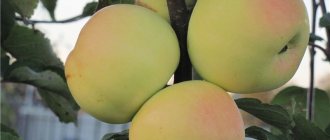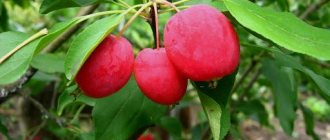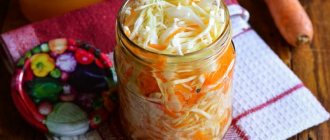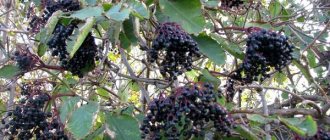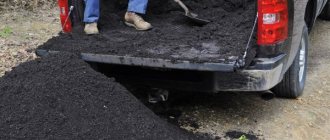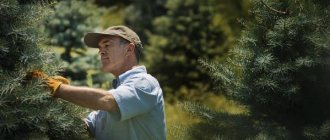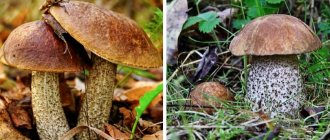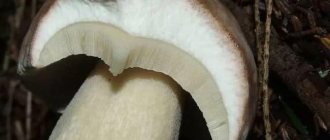Gardening » Apple tree
0
493
Article rating
Kira Stoletova
There are many different stories about why an apple turns dark when cut, but some of them are just fiction, which some believe due to ignorance of the true reasons. Let's consider all the possible answers to this question and come to a logical conclusion.
Reasons for darkening of apples when cut
Excess moisture
There are several factors that cause the core of an apple to turn brown. First of all, unfavorable climatic conditions in the summer, when it often rains, may be to blame. Excessive watering shortly before harvest can also cause damage. In general, any excess moisture, starting in August, increases the risk of fruit damage and can shorten their shelf life. But you can eat such apples if you remove the damaged part.
EVERYTHING YOU NEED FOR THIS ARTICLE IS HERE >>>
Preventing dark spots
Hyacinths have faded: what to do with them next
Knowing why black spots can appear on apples, and that the fungal disease scab is to blame, its appearance can be prevented if you carry out preventive work in a timely manner. Every gardener should know what to do to protect his apple orchard:
- Prevention is necessary in the fall. This is necessary in order to prevent the fungus from overwintering in the foliage and an outbreak of the disease in the spring.
- Strictly follow the rules of agricultural technology.
- Apply the correct fertilizer regularly. If a tree receives a sufficient amount of nutrients and mineral elements, its immunity will be stronger and its resistance to fungal diseases and parasites will be higher.
- Carry out preventive treatments regularly with specialized solutions. Biological products are used. They must be used before buds form. Bordeaux mixture shows good results as a prophylactic agent.
- Every 5 years, it is recommended to add lime to the ground around the tree at the rate of 100 g per square meter. If the soil is highly acidic, you will have to apply double amounts of lime every year.
Additional Information! It is necessary to carry out preventive treatment of trees every 2 weeks until buds appear.
Preventive and therapeutic measures should begin as soon as the first small inclusions appear
The fight against scab is a very long process, because if it is present on neighboring trees, the risk of infection is very high. Proper agricultural practices will help reduce the likelihood of fungal infection:
- Select healthy seedlings without signs of any damage, with a well-developed root system.
- Maintain a distance between seedlings of at least 3 m. Due to densely planted trees, their crowns begin to intertwine, the sun's rays do not penetrate well, and air circulation decreases. This creates favorable conditions for the penetration and spread of fungus.
- Fertilizers must be applied strictly in the dosages specified by the manufacturer.
- Proper watering. You must not allow the soil to dry out or stagnate water, which can cause the roots to rot.
Careful garden care will prevent the development of scab.
Attention! If all preventive measures are taken, but the scab still returns, most likely the problem is a low pH level in the soil.
Lack of calcium, too much nitrogen
But another, more serious problem occurs when not only the core and the pulp around it darkens, but also the entire apple. In this case, the development of the disease begins in the pulp zone - between the skin and the seed chamber. Brown spots have clearly defined boundaries and increase in size over time. After several months of storage of diseased fruits, visible marks appear on the surface of the skin. These are gray-green spots that do not have clear boundaries.
In very rare cases, rot affects the seed chamber. The pulp becomes bitter to taste and is unsuitable for food. In this case, the cause of apple spoilage is a lack of calcium in the soil during fruit growth and ripening, as well as the application of excessive amounts of nitrogen-containing fertilizers. The quality of the fruit can also be affected by untimely harvesting - later than the due date.
Apples are watery and transparent
This is the glassiness of the fruit . The apples seem literally transparent, the flesh looks watery when cut. There is a misconception that this is an indicator of particularly high quality fruits. In fact, there is no reason for joy here: the glassiness of apples indicates a severe lack of calcium. It forms the walls of cell membranes; With calcium deficiency, they become fragile, the cells are damaged and lose juice. Such apples do not store well and quickly lose their taste.
Solution . Glassy fruits found in storage should be consumed as soon as possible. They are also removed from the tree immediately after discovery and stored separately from other apples. In the future, it should be taken into account that a lack of calcium may be associated with acidification of the soil. To restore balance in the fall, dig up the tree trunks of fruit trees (after all, not only apple trees suffer from a lack of calcium) and add dolomite flour at the rate of 4-5 kg per hundred square meters. Dolomite flour is preferable to other soil deoxidizers (fluff lime and wood ash), as it additionally enriches the soil with magnesium. Next year, closer to harvest, spray the trees twice with a 1% solution of calcium chloride: the first time five weeks, the second time three weeks before harvesting the fruits.
How can I help you?
If, when planting the crop, a problem of darkening of some fruits is discovered, all apples can be sprayed with an aqueous solution of calcium salts. All storage conditions must be observed: air exchange, temperature, humidity.
On a note
Breeders have developed varieties with good shelf life. Idared, Antey, Alesya, Golden Delicious, Darunok apples can be stored until spring.
© Author: Nikolay Dmitrievich ERMIKOV, Bryansk
How to prevent darkening
Frankly speaking, a dark apple does not look very attractive. Therefore, you can try to prevent the darkening mechanism. There are several ways:
- Acid. Citrus juice or citric acid will keep the slices in their original form, although they will acquire a slight sourness.
- Sugar syrup has the same effect, but will add sweetness to the fruit.
- Carbonated drinks that contain both sugar and acid are also suitable. They just need to sprinkle pieces of fruit.
- Larger pieces can be saved by splitting them in half and taking out the middle, then putting the cut back together. Afterwards they need to be wrapped well in a bag so that no air gets in.
A cross-section of an apple that has not yet turned black.
Of course, darkened apples lack their juicy, appetizing appearance. But they do not pose any harm to people; amateurs do not have to worry about an eating disorder. But if you want to preserve the original appearance, now, armed with knowledge, it’s easy to do.
WHY DO IMMENSE APPLES SHIELD?
Sometimes unripe apples fall off the tree. There may be several reasons for this phenomenon.
The most common one is the codling moth. To prevent infestation by this pest; It is imperative to treat the trees with insecticides several times during the season: the first time after the ovaries fall off in July and then 2-3 more times.
The reason may also be excessive application of nitrogen to the soil in the spring. In this case, feed the apple tree with superphosphate (20-25 g per 10 liters of water). Make a groove along the entire periphery of the crown and pour fertilizer into it - a bucket for each linear meter.
Shedding of apples is also possible with a lack of potassium. Potassium sulfate will help here. Dilute 15-20 g of the drug in 10 liters of water and pour the same dose into the groove.
And another reason for the fall of apples is water shortage. Urgently water the apple trees from which unripe fruits have begun to fall off and then irrigate them thoroughly; once every two weeks will be sufficient.
© Author: Ekaterina Nikolaevna GRIGORYEVA, Kaluga
Apples: reasons for early falling
The apples are very small
Potassium deficiency . The fruits are unusually small compared to the norm for their variety and previous harvests, and are poorly stored; at the same time, flowering could be unusually abundant. If, in addition, the orchard suffered from frost in the winter, and in the middle of summer the leaves were wrinkled, curled and died along with the petioles, we can talk about potassium starvation of the plants. Potassium deficiency is often characteristic of light and especially peaty soils.
Solution . The next time you dig up the soil in autumn, apply phosphorus-potassium fertilizers (azophoska, nitroammofoska or special autumn fertilizers). Industrial fertilizers can be replaced with ordinary wood ash. Phosphorus-potassium fertilizing not only replenishes the deficiency of microelements, but also increases the frost resistance of fruit trees. Remember that potassium is an antagonist of calcium and displaces it from the soil, so strictly follow the dosage of fertilizers.
Read also: How to make a trellis in a greenhouse
HOW TO REJUVENATE AN APPLE TREE?
All plants have a maximum fruiting period. And when it comes to fruit trees, you always want to prolong it, because so much effort was devoted to their planting and development. With the right approach, the apple tree can be rejuvenated, and then it will continue to delight with delicious fruits.
The essence of the update
The key to long fruiting lies in the optimal number of branches and their correct shape. The apple tree shows the first signs of deterioration 30 years after planting: exposure of skeletal-forming branches. These areas no longer bear fruit, side shoots do not develop on them, and yields drop. The fruits become smaller and their taste suffers. By the way, such signs may appear earlier if the tree has not received the necessary care.
But even the most dilapidated tree can be revived. To do this, you need to restore the correct shape of the crown. Of course, this is not a quick task, because the operation of forming the crown is stressful for the tree and if everything is done at once, the apple tree may die. Ideally, 3 seasons will be allocated for all work. So what should you do?
Contents of work
We prune old apple trees after fruiting and leaf fall, but before the onset of frost. The ideal temperature is 10 degrees Celsius. The point of pruning for renewal is that only the necessary branches and shoots should remain on the tree, which are evenly spaced, without interfering with each other and receiving enough sun. Under no circumstances should you leave two leading trunks on a tree; one of them will have to be cut down.
Don't forget to feed the apple tree. After the first pruning, you need to add potassium-phosphorus fertilizers to the soil near the tree. In spring, nitrogen-containing mixtures can be added. Fertilizers are also used during the flowering period. If the weather is rainy, apply the compositions to the soil dry. In hot weather, you can dilute them with water.
Chronology
In chronological order, everything looks like this.
1st year: in the summer, inspect the apple tree for weak, dry, damaged branches that need to be marked: they should be removed first in the fall. Be sure to cut them to the ground, do not leave stumps. But do not remove more than 3 large branches in one season. Next, take care of the crown. The optimal height of the apple tree is 4 m. If the tree has grown taller, then you need to shorten the crown, but in one year you can only trim it by 30-35 cm. At the same time, all thin, dead branches should be removed.
2nd year: in the spring, inspect the apple tree and, if new shoots have appeared, leave one on each branch, remove the rest. In autumn, reduce the crown height by another 30-35 cm.
The 3rd year is the most important: half of the new shoots should be cut off and the formation of the crown should be completed. Remove old and dry branches. In the third year, the condition of the apple tree can already be seen and a decision can be made whether to remove additional shoots or allow them to form into branches.
© Author: Nikolay Fedorovich MARCHENKOV, Penza region, Nizhny Lomov
How to rejuvenate old apple trees
Visual signs of disease diagnosis
- Epidermal changes:
- reddish-brown color of the bark, which cannot be peeled off - cytoporosis;
- lamellar plaque of silver or blue-green color - lichen;
- cracking of the bark - sun-frost burn, black cancer;
- discoloration of the bark to red-brown, difficulty in its detachment - cytoporosis;
- thickenings appear that turn into ugly growths - ordinary cancer;
- growths in the form of a mushroom with a cap - tinder fungi;
- Branch changes:
- unnatural curvature - grooved wood;
- flattening of branches - grooved wood;
- young shoots bend in the form of a whip - bacterial burn.
- Change sheet:
If you find an error, please select a piece of text and press Ctrl+Enter.
Almost all apples have a brown core. This didn't happen before. Tell me what to do?
NOTE: WHICH APPLES ARE HEALTHIER – GREEN OR RED?
American researchers have discovered substances in apples that protect brain cells from destruction. And scientists from Finland found that people who eat just one small fruit a day have the lowest risk of developing a stroke. Apples have also been proven to reduce the level of bad cholesterol in the blood.
Mostly useful substances are found in the peel of the fruit and directly under it - it contains 10 chemical compounds that have the property of suppressing and destroying cancer cells. Therefore, you should not peel apples before eating.
Many people are often interested in: which apples to eat – green or red? Green ones are still better. They contain more vitamin C, and they are less likely to cause allergies. It is not without reason that it is recommended to introduce green apples into the diet of infants.
Determining which apples will bring the greatest benefit to the body is not difficult at all. If the cut fruit turns pinkish-brown after a few minutes, you have hit the mark with your choice!
© Author: Anna Pavlovna NOSHA
ORDER QUALITY AND CHEAP SEEDS AND OTHER GOODS FOR YOUR HOME AND GARDEN. PRICES ARE PRICEY. CHECKED! JUST LOOK FOR YOURSELF AND BE SURPRISED. THERE ARE REVIEWS. GO>>>
Below are other entries on the topic “Do-it-yourself cottage and garden”
- Brown and brown spots on apples - the reason?: APPLES ARE NOT STORED. WHAT...
- Why young apples fall off: The reason why young unripe apples fall off Often...
- Apple tree Honey Crisp - description and reviews: DESCRIPTION OF APPLE TREE HONEY CRISP (HONEY...
- To have less carrion on apple trees - reasons and what to do: WHY APPLE TREE HAS A LOT OF CARRIAGE...
- Why do apples taste bitter??: WHY DO APPLES TASTE BITTER? Sometimes...
- Do-it-yourself multilayer bed with... apples: How to make a layered bed Layer beds,...
- How can you use carrion of apples?: CARRIAGE OF APPLES: HOW TO “SQUEEZE” FROM…
Subscribe to updates in our groups and share.
Apples rot
Bitter fruit rot . Brown spots with clear outlines appear on the fruits, then they stratify into dark and light, slightly pinkish, concentric circles. The pulp becomes bitter and has an unpleasant odor, apples quickly deteriorate, and rot easily spreads from diseased fruits to healthy ones. Storing apples in the cold does not protect against disease, since rot can develop even at temperatures around zero.
Solution . The fungi that cause the disease settle on open wounds after improper or careless pruning and gradually move to the fruits. Trim fruit trees strictly according to technology, disinfect tools when moving from tree to tree, be sure to cover large cuts with varnish or Rannet paste.
Black fruit rot. Concentric circles of gray velvety growths appear on the apple, and the fruit quickly turns black.
Solution . Preventive measures are the same as against bitter rot.
Causes of cracks in apples
Infections enter apples through cracks.
Cracks not only spoil the presentation of the apple, but also open the way for infection to enter the fruit, as a result of which it begins to rot. The following can lead to damage:
- scab damage. On infected areas of the apple, the peel becomes coarser and dies, and a cork growth forms. The healthy part of the fruit continues to grow at this time, thereby causing cracking;
Trees of the Putivka, Babushkino, Pepin Litovskiy, Melba, and Borovinka varieties are most susceptible to scab infection. Resistant apple trees include Wellsey, Boy-ken, Pepin saffron, and Belarusian sinap.
- uneven humidity level. After a dry period, volume watering can cause cracks to appear. For apples deprived of moisture, the peel becomes coarser, and when the missing liquid is received, the fruits begin to rapidly gain weight. The peel cannot withstand the pressure and begins to crack;
- contrasting weather conditions. The varieties Boskop, Cox Orange, Holsteiner Cox and Ingrid Maria are especially sensitive to weather fluctuations;
- overripening of early varieties;
- characteristics of the place of growth. Trees growing on slopes have rougher skin;
- nutritional deficiency. Excess nitrogen combined with calcium deficiency causes the peel to burst.
If cracks appear on the fruits, it is impossible to prevent the penetration of fungal infections into them by spraying.
Protecting the apple tree from diseases and pests (video)
Causes of other problems
In addition to shedding and cracking, apples are also susceptible to other anomalies that spoil both the appearance of the fruit and its taste characteristics.
Rotting
Apples begin to rot for several reasons:
- infection with moniliosis. The fungal disease is carried by wind and insects and appears more often in humid and warm environments. The varieties Papirovka, Antonovka vulgaris, Melba, as well as Aport, Borovinka, Renet Landsbergsky, Renet Pisguda, Breading are not resistant to fruit rot. Less susceptible to infection: Butskoe, Pepinka Lithuanian, Titovka and Pepin saffron, Stettinskoe red, Jonathan, Parmen winter golden.
- damage by insects, codling moth, scab;
- appearance of cracks.
Rot appears as a result of moniliosis infection
They're getting smaller
The formation of small fruits is caused by:
- the tree is overloaded with apples;
- lack of moisture or calcium;
- age of the tree;
- thickened branches and plantings.
They're bitter
Apples begin to taste bitter when they are affected by bitter pitting, Jonathan's spot against the background of a deficiency of potassium, magnesium and calcium.
Are deformed
Growths and mounds are a genetic feature of the Zhigulevskoe and Antonovka varieties. If the growths are accompanied by cracking of the fruit, you should think about scab damage.
Deformed fruits also appear when flowers or ovaries are damaged by frost, hail, or sawfly pests.
Deformed fruits appear as a result of damage to flowers or ovaries by frost or sawfly pests
Scratches and warts are caused by the weevil. Traces of vital activity in the form of wormholes on the fruits indicate the presence of hawthorn caterpillars, leaf rollers, moths, and rowan moths.
The core of an apparently healthy fruit turns brown under the influence of heavy rains or abundant watering before ripening.
How to prevent darkening
Of course, the property of almost all apples to change color after their integrity is violated is not to the taste of many - brownish fruits lose their appetizing appearance, especially if you need to prepare a festive slice for the table.
Let's look at a few simple ways to help keep apples looking beautiful and juicy.
- Vitamin C, which is found in the juice of any citrus fruit, will come to the rescue. It neutralizes the interaction of enzymes with oxygen in air. It is enough to lubricate the cut with lemon or orange juice and it will not turn black. It is worth remembering that fruits processed with juice will be slightly sour.
- Instead of citrus juice, you can use citric acid. A small amount of the substance must be diluted in cold water, cut the fruit and place the slices in the solution for 5-6 minutes.
- Sugar syrup can also prevent discoloration. If you dip the slice in the syrup for a few seconds, it will not darken, but it will taste even sweeter.
- You can sprinkle the cut with sweet carbonated water, which contains citric acid and sugar.
- If you need to take a cut apple with you, for example, on a trip or to school, then this method is suitable: cut the fruit into 2 halves, carefully remove the core, put the halves together and tighten them with one or two rubber bands. Then the fruit must be packed in a bag. Oxygen will not be able to reach the cut part, and it will remain light.
Typical diseases of pome crops
If the entire core of a clean-looking apple is brown, then this may be Fusarium rot or simply a lack of microelements in the soil (a common occurrence on poor soils, particularly in the North-West). If there is a lack of microelements, the apple tree should be sprayed with either Aquadon-micro or Uniflor-micro. This should be done at the moment of formation of the ovaries. Fruits with a lack of microelements are quite edible.
If it is rot, then the fruits are inedible and have a bitter taste. The disease most often manifests itself during storage.
Sometimes the apple begins to rot right on the tree. This is fruit (bitter) rot. Usually, later concentric folds appear on the fruits, strewn with white pycnidia with fungal spores. In this case, it would be a good idea to spray the tree with Zircon or Novosil (Silk) in order to prevent fruit rot from spreading to healthy fruits. In general, there are many rots, all of them are fungal diseases. Most of them appear during storage. Select for storage whole fruits that are collected without bruises. It’s a good idea to spray the fruits with Fitosporin before storing them, then dry them and then put them in boxes, sandwiching them with dry straw or wrapping each apple in a piece of newspaper.
If the fruits acquire a metallic sheen, then this is also a fungal disease - a milky sheen. Fruits start to get sick right on the trees, usually after a harsh winter, when the wood is frozen. As soon as you notice such leaves, immediately spray with Zircon, increasing the dose to 4-5 drops per 1 liter, so that the disease does not spread and spread to other fruits, since they will not be stored. Urgently feed the tree with “Extrasol”, “Uniflor-bud”, “Solution” or other fast-acting preparations. In general, after a harsh winter, fruit trees, and indeed all plants in the garden, should be given more attention.
Why does apple flesh sometimes have a “glassy” appearance? Glassiness of fruits appears either when the fruits are frozen directly on the trees during small early autumn frosts (usually this happens with late varieties that have not had time to ripen), or during prolonged rainy weather before harvesting (due to too much water in the cell sap of apples). It usually appears during storage. Such apples are poorly stored and the taste of the fruit decreases.
If apples and pears become covered with black spots (and even cracks), then this is scab. First it appears on the leaves in the form of black spots, then it spreads to the fruits. The best and most harmless remedy is regular spraying of such an apple or pear tree with the “Healthy Garden” preparation. You can also use “Zircon” or “Amulet” (there is also a drug that also belongs to the new generation of biological products).
Nowadays a lot is written in the press about apple trees with innate immunity against scab. This is a nasty fungal disease in which the fruits lose their presentation due to black growths and cracks. Therefore, the apple trees bred by E. N. Sedov at the Oryol fruit and berry experimental station deserve attention. But Orel is not Peter. These apple trees do not live here, but survive: our climate is unsuitable for them. So don't fall for the advertising. True, among them there is an interesting variety for the North-West called Orlovskaya Garland. For zones with a continental climate, Oryol apple trees are what you need.
Is it possible to use Nitrafen against scab on an apple or pear tree? No. This is a very strong poison, it can be used at a distance of 200-400 m from housing, so it is prohibited for use in garden areas. And no amount of talk about the fact that it is used in early spring, when there are no beneficial insects yet, does not make its use safe, because Nitrafen will fall into wells and reservoirs with spring waters.
Other problems
If the apple tree leaned to one side or fell completely, then its roots were eaten by a water rat (similar to a muskrat, but smaller). The rat does not know how to dig the ground itself and runs through the mole passages. Therefore, if a mole lives on the site, then a rat will definitely appear. The mole is a predator; it does not feed on roots, but only on insect larvae and earthworms. He can cut off his roots when he builds his galleries. But the rat is a herbivorous animal; it eats root vegetables, tubers, and plant roots. It's not easy to get rid of it. You can throw bait-poison “Ratifenkro” or “Moleboy” into the mole tunnels. But I’ll say right away that this is ineffective. The rat, perhaps, would have eaten the bait, but the mole throws it out of its passages onto the surface. You can, however, set traps just like for a mole, but the easiest way is to sow black root (not to be confused with black root) on the side of the plot along the ditches. Its seeds will cling to the skin of animals at any time of the year. This causes them nervous stress, since they cannot clean out the seeds on their own, and the matted fur gets wet in the water, which leads to the death of the animals.
What to do if the trunk of an apple or pear tree falls into two parts?
Reconnect both parts of the barrel and fasten them together with metal staples. Then cover the gap with a mixture of clay and mullein or fill it with garden varnish and tie it with canvas. After a year, the canvas can be removed.
Are birds beneficial in the garden?
Depends on what. Insectivorous birds are also our faithful helpers. Tits are very useful. Less known, but also useful, are the flycatcher, the robin, the blue tit, the redstart, the wagtail, the Muscovy, the nuthatch, the woodpecker, and the jackdaw. But I would not allow starlings and magpies into the garden, because they cause great damage to the berries.
It is easy to attract titmouse to the garden if you tie unsalted lard to tree trunks, hang titmouses, feed the birds, especially in winter, with unroasted seeds, and most importantly, do not use pesticides. It has been noticed that after using Nitrafen there will be no birds in the garden for 5-6 years. After using Intavir, the birds immediately leave the garden.
Updated: 2019-07-10 00:03:15
- Pol-pal is an annual plant; if you cut it and put it in a warm room for the winter, then it is a biennial. Term
- The first thing you need to pay attention to is the condition of your teeth. If teeth react painfully to cold or hot,
- Mental health Personal hygiene Sleep Healthy eating Healthy lifestyle more Over time, you will find that a healthy lifestyle becomes
- Cellulite is not a skin defect, as is often mistakenly thought. This is a disease of an unbalanced body. Symptoms: orange peel effect
- Eating poor quality food can cause discomfort or acute poisoning. In recent years, despite warnings from doctors in the media
- Before you try to normalize your vision, you need to master four relaxation exercises: solarization, palming


